The Sack of Lawrence
Tour Stop
Directions: Symbolic of the aftermath of The Sack of Lawrence, the site of the destroyed Free State Hotel is currently occupied by the Eldridge Hotel [ Waypoint = N38 58.268 W95 14.157 ] which is located at 701 Massachusetts Street in Lawrence in Kansas 66044.
- Return to your car and get headed east on W 6th Street (US Highway 40).
- After about three blocks, turn right (south) onto Massachusetts Street. You should turn right after you see the “Welcome to Downtown Lawrence” sign.
- Find a place to park on Massachusetts Street. You may want to put enough money into the parking meter to cover your visit of the next three tour stops (Eldridge Hotel, Watkins Community Museum, and the John Brown and the Siege of Lawrence Historical Marker).
- Walk up the west side of Massachusetts Street to the southwest corner of the intersection with 7th Street.
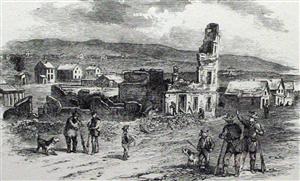 Description: You are standing in the location of the Free State Hotel which was built in 1855 but destroyed during the Sack of Lawrence before it had been completely finished. Built in 1855 by agents from the New England Emigrant Aid Society, the Free State Hotel was needed to provide temporary housing for Free-State supporters arriving in the Kansas Territory.
Description: You are standing in the location of the Free State Hotel which was built in 1855 but destroyed during the Sack of Lawrence before it had been completely finished. Built in 1855 by agents from the New England Emigrant Aid Society, the Free State Hotel was needed to provide temporary housing for Free-State supporters arriving in the Kansas Territory.
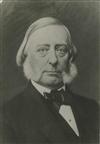 Events leading up to the Sack of Lawrence began on March 30, 1855 when Territorial Governor Andrew Reeder held the first elections for the legislature in the Kansas Territory. Thousands of Missourians would cross the border on election day and vote in these elections. As a result, 37 out of the 38 legislators elected were pro-slavery candidates.
Events leading up to the Sack of Lawrence began on March 30, 1855 when Territorial Governor Andrew Reeder held the first elections for the legislature in the Kansas Territory. Thousands of Missourians would cross the border on election day and vote in these elections. As a result, 37 out of the 38 legislators elected were pro-slavery candidates.
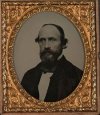 Free State leaders protested the election to no avail. In response, they chose to organize their own constitutional convention. In October of 1855, they would hold the Topeka Constitutional Convention in Topeka, Kansas. Then on January 15, 1856, the Free State leaders would hold an election for their own territorial legislature.
Free State leaders protested the election to no avail. In response, they chose to organize their own constitutional convention. In October of 1855, they would hold the Topeka Constitutional Convention in Topeka, Kansas. Then on January 15, 1856, the Free State leaders would hold an election for their own territorial legislature. 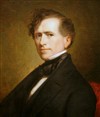 On January 15th, free-state voters elected Charles Robinson to be their territorial governor. The President of the United States, Franklin Pierce, called the Free State Legislature unlawful and called for the arrest of its leaders. The President ended up sending Federal troops to For Leavenworth in the Kansas Territory.
On January 15th, free-state voters elected Charles Robinson to be their territorial governor. The President of the United States, Franklin Pierce, called the Free State Legislature unlawful and called for the arrest of its leaders. The President ended up sending Federal troops to For Leavenworth in the Kansas Territory.
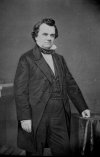 When the government elected on January 15th took their oaths of office in Topeka in March, Douglas County Sheriff Samuel J. Jones
When the government elected on January 15th took their oaths of office in Topeka in March, Douglas County Sheriff Samuel J. Jones 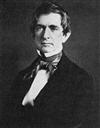 recorded their names and was fully expected to arrest them for treason. The Topeka government persevered and sent James H. Lane to Washington with a petition to the US Congress asking for the admission of Kansas into the Union as a free state. There were many irregularities in the documents, but the debate in congress was heated. Illinois Senator Stephen Douglas attacked the petition as fraudulent. Senator William Seward argued in support of admitting Kansas as a free state.
recorded their names and was fully expected to arrest them for treason. The Topeka government persevered and sent James H. Lane to Washington with a petition to the US Congress asking for the admission of Kansas into the Union as a free state. There were many irregularities in the documents, but the debate in congress was heated. Illinois Senator Stephen Douglas attacked the petition as fraudulent. Senator William Seward argued in support of admitting Kansas as a free state.
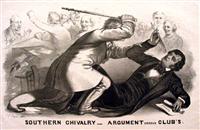 The debate was so virulent that James Lane went so far to challenge Senator Douglas to a duel. Douglas refused to accept the challenge. In May, Senator Charles Sumner from Massachusetts delivered his famous speech, “A Crime Against Kansas,” in which he used particularly offensive language against Senator Douglas and Senator A. P. Butler from South Carolina. A few days later Congressman Preston Brooks from South Carolina sought revenge for the attack against Butler and savagely beat Sumner on the Senate floor.
The debate was so virulent that James Lane went so far to challenge Senator Douglas to a duel. Douglas refused to accept the challenge. In May, Senator Charles Sumner from Massachusetts delivered his famous speech, “A Crime Against Kansas,” in which he used particularly offensive language against Senator Douglas and Senator A. P. Butler from South Carolina. A few days later Congressman Preston Brooks from South Carolina sought revenge for the attack against Butler and savagely beat Sumner on the Senate floor.
Meanwhile, the officially recognized, territorial government continued in their efforts to restrict the free state movement in Kansas. On May 5, 1856, a grand jury of the United States District Court at Lecompton under the presiding judge, Samuel D. Lecompte issued indictments against the free state officials, including Charles Robinson and Andrew Reeder. Both Robinson and Reeder attempted to avoid capture, but Robinson was caught and imprisoned at the territorial capital in Lecompton, Kansas.
Judge Lecompte's judgment included a ruling that labeled the Free State Hotel (current location of The Eldridge House) and two newspapers in Lawrence as nuisances. The judgment ordered them to be shut down. The U.S. Marshal for Kansas Territory, Israel. B. Donaldson, took a posse of around 700 men, including Sheriff Sam Jones, to Lawrence to execute the court orders. By late May Marshal Donaldson and his posse had surrounded Lawrence, Kansas. Fearing for the safety of their town, the leaders in Lawrence sent notice to Marshal Donaldson that they would comply with the court's orders. Donaldson entered Lawrence and made his arrests. Having completed his orders, Donaldson released the posse. Sheriff Jones immediately enlisted the posse to support his plan to disarm Lawrence and destroy the free state newspapers.
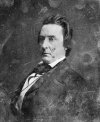
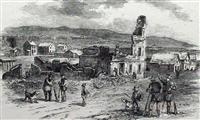 On May 21st, Sheriff Jones entered town with 20 men and demanded that Samuel Pomeroy turn over all of the town's cannon and rifles. Pomeroy complied with the order and no resistance was offered by the free state men. The pro-slavery posse proceeded to destroy Lawrence's two free state newspapers, the Herald of Freedom and the Kansas Free State. David Rice Atchinson directed the first cannon that fired on the Free State Hotel, but the ensuing cannon fire failed to damage the heavily fortified structure. It was eventually destroyed with an incendiary device. Charles Robinson's house on Mount Oread was burned down by members of the posse. Sheriff Jones was later quoted as saying, “This is the happiest day of my life, I assure you.”
On May 21st, Sheriff Jones entered town with 20 men and demanded that Samuel Pomeroy turn over all of the town's cannon and rifles. Pomeroy complied with the order and no resistance was offered by the free state men. The pro-slavery posse proceeded to destroy Lawrence's two free state newspapers, the Herald of Freedom and the Kansas Free State. David Rice Atchinson directed the first cannon that fired on the Free State Hotel, but the ensuing cannon fire failed to damage the heavily fortified structure. It was eventually destroyed with an incendiary device. Charles Robinson's house on Mount Oread was burned down by members of the posse. Sheriff Jones was later quoted as saying, “This is the happiest day of my life, I assure you.”
Now the free state propaganda machine worked overtime to discredit the pro-slavery men responsible for was being called the Sack of Lawrence.
Back: Lawrence Historical Marker
Next: The Free State Hotel
